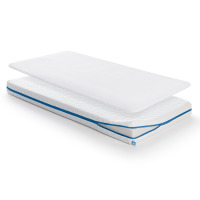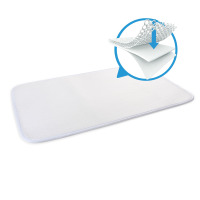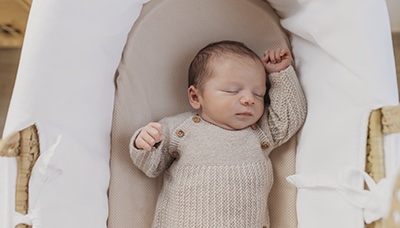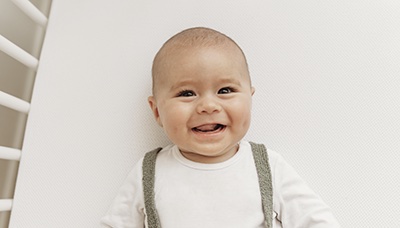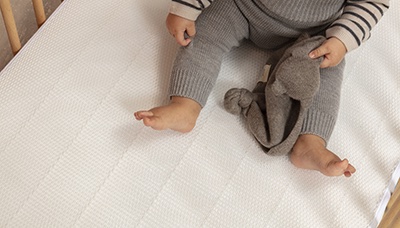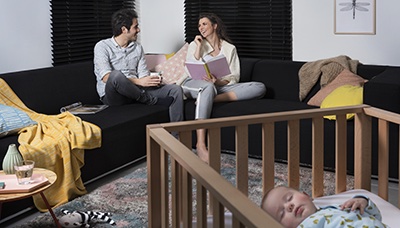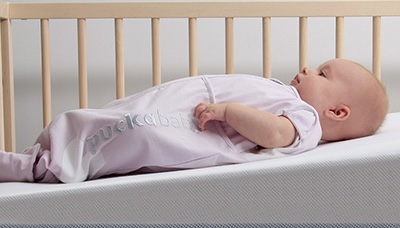Guest blog by sleep expert Lise Dullaerts from @debabyslaapcoach
It is important to note that every baby is unique and individual experiences may vary. For many parents and babies, a crib/cot is an ideal sleep environment. For other families, this sleep environment is only beneficial for a short period of time or perhaps not at all. But not to worry... There are other sleeping solutions that can help improve your little one's sleep. Each type of sleeping environment comes with its respective pros and cons. We've outlined each of these for you.
The bed types in comparison


COT - CRIB
The best-known sleep location/environment for an infant is a crib or cot. Accordingly, many parents plan for their little one to sleep in this type of bed.
Pros of a cot/crib
- Safe
Crib/cots provide a safe sleeping environment for babies. The closed sides of the crib prevent the baby from rolling out. - Comfortable
A crib/cot with a firm mattress and tight-fitting sheet provides a comfortable sleeping surface for baby. - Helps develop healthy sleep habits
By offering a consistent sleep location, babies learn to associate the crib with sleep. This association can help develop healthy sleep habits, making it easier for them to fall asleep and sleep through the night. - Reduced risk of sudden infant death syndrome (SIDS)
When you follow safe sleep guidelines, you can reduce the risk of SIDS.
Cons of a cot/crib
- For some infants or young children, a crib/cot unexpectedly disrupts their ability to sleep independently or can interfere with a child's autonomy. A young child is dependent on the parent to get in and out of the crib/cot. Consequently, the toddler with increasing need for autonomy, the baby who has always slept with their parents in bed or the little one who has difficulty self-regulating can experience the physical barrier as frustrating interference. This can keep these children from becoming restful enough to fall asleep.


FLOOR BED
Up until a few years ago, the floor bed was relatively unknown and is now rapidly gaining popularity. A "Montessori" floor bed is a concept derived from Maria Montessori's educational philosophy that emphasises independence, freedom of movement and a child-centred environment. A floor bed is a mattress that is low, as close to the ground as possible, without the use of a bassinet or crib/cot.
The rationale behind the use of a floor bed is that the cot/crib was developed primarily for the parent and not for the child. Within a cot, the child has no freedom or independence, which can hinder the child's autonomous development.
Pros of a floor bed
- Freedom of movement
A floor bed allows babies and young children to move freely in and out of bed, which promotes independence and discovery. It allows them to practice gross motor skills, such as crawling and rolling, without restrictions imposed by a cot. - Accessibility
As the floor bed is at floor level, children can get in and out of bed independently. This promotes independence and allows them to make choices about their sleep routines. - Sleep independence
Montessori philosophy encourages children to develop healthy sleep habits and self-regulation. With a floor bed, children have the freedom to decide when they are ready to sleep or wake up, allowing them to develop their natural sleep patterns.
Cons of a floor bed
- Transitioning from co-sleeper or crib
The transition from a co-sleeper, bassinet or cot to a floor bed is a significant milestone. It is advisable to introduce a floor bed when the child is developmentally ready and can safely navigate the sleeping area. The timing of this transition may vary from child to child - Safety
Although floor beds are safe (when used correctly), it is important to take precautions to ensure the child's well-being. The sleeping area should be free of hazards and the room should be child-safe to prevent accidents.
Believe it or not, a floor bed can be used from birth! Some families choose to use a floor bed for their newborns rather than a traditional co-sleeper or baby bed. It is, however, important to note that using a floor bed for a newborn involves specific considerations and precautions. Obtain detailed information about this from your paediatrician or professionals with expertise in Montessori principles.


TODDLER BED
A toddler bed is effectively a transitional bed between the crib/cot and a big bed. It looks and feels already like a “regular” bed but is just smaller in size, usually 70x140/150/160 cm.
A toddler bed is often used when little ones get too big for the cot/crib or try to climb out of it. It is only advisable to switch to a toddler bed around 2.5-3 years of age.
Pros of a toddler bed
- Toddlers can crawl in and out of bed on their own, which can boost their independence, as with the floor bed.
- These beds are sized to accommodate the growing toddler, which can create a form of security and safety.
Cons of a toddler bed
- This bed is only used for a limited period of time, so this can be quite an investment.
- Some toddler beds are too high, which poses a fall hazard for young children. A safety rail can be helpful.
- The toddler/preschooler can get out of bed so it is best to make the room toddler-proof!
What is the ideal age to move a child to a toddler bed? This is mainly determined by the child's motor development. The child should be able to get in and out of the bed without being injured. Likewise, if a little one is attempting to climb out of a cot bed, it may be advisable to offer a toddler bed, for safety reasons.
EXTRA MATTRESS
The last sleeping location is the extra mattress. This is a mattress placed on the floor in the parents' room. Should your little one have difficulty falling back asleep during the night, your child can come to you and continue sleeping on the mattress next to your bed. There are different methods for this.
My "rule" is that the extra mattress can be used by the toddler on the condition that they do not wake up their parents or siblings during the night and simply come and lie quietly in the room. Does it not work? In that case I advise parents to take their little one back to their own room and stay there until the child can fall back asleep. This is not as punishment, but rather as support. If the child makes noise, both parents will wake up and/or their little sibling still sleeping in the parents’ room. It is evident that the child in question still needs additional support and it is then better to provide this in the child's own room.


Which bed will it be? It’s up to you!
It is important to consider your own comfort level and preferences when choosing a sleeping arrangement for your baby. Some parents choose to start with a traditional cot and switch to a floor bed. Others choose co-sleeping and then a cot.
Fascinated by the Montessori approach? Consult a paediatrician or professional with expertise in Montessori principles to receive appropriate guidance and support right from birth.
For most beds we offer 3D protectors and even matching mattresses. Have a look here and browse through our products!

